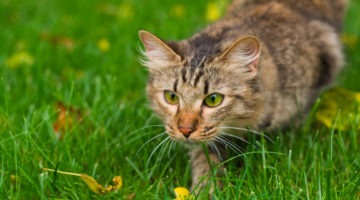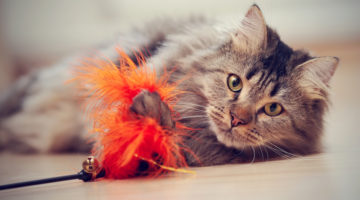It’s natural for cats to stalk birds. Check out seven ways to satisfy those hunting instincts without harming any wildlife.
Cats love to hunt. It’s a trait even cat lovers don’t appreciate, especially when their kitties deposit a dead bird on the kitchen floor. And for those who love backyard bird-watching, roaming cats are nothing short of anathema. More than one neighborhood feud has been triggered by someone’s outdoor cat preying on next door’s feeder birds.
As much as we may dislike their craving for wild birds, it’s feline nature to stalk and catch small critters. Their wild ancestors had to hunt to survive, and this instinct is still a big part of the domestic cat’s makeup, even if he or she gets well fed at home.
It seems callous to deny a cat’s natural need to stalk and hunt, but at the same time it’s not responsible to let them have carte blanche when it comes to wild birds, especially today when so many species are already endangered and at risk.
Here are seven ways to satisfy your feline’s inner hunter while keeping songbirds (as well as chipmunks, butterflies and other garden visitors) out of her clutches.
- Don’t let your cat roam. Not only is it dangerous for her, but it also leaves you with no control over her hunting habits.
- If your cat won’t adapt to being indoors, consider an enclosure for the backyard, or take her for supervised outings on a leash. This gives her the opportunity to be outside and watch wildlife up close without getting her claws into it.
- Even an all-indoor cat can exercise her stalking skills in a safe way. Situate a bird feeder close to a window where she can sit and watch the comings and goings through the glass. Locate the feeder no more than 3’ from the window – that way, your cat has a good view, yet birds startled from the feeder can’t get up enough momentum to kill themselves if they hit the glass.
- Some cats love watching birds and small animals on TV. Buy DVDs designed especially for cats; they feature close-up footage of birds, fish, squirrels and other small animals.
- Cats also like to chase and catch things. Spend at least 15 minutes a day actively playing with your cat by tossing toys or small balls for her, or dragging a string, swizzle toy or feather toy around the house. Laser pointers are a hit with a lot of cats – just make sure you never shine the light into their eyes.
- Add challenge and variety to interactive play by going around corners and up and down stairs, or having the toy “hide” in a box or under a chair. Let the cat catch the toy now and then.
- When you can’t be around, leave out toys that will encourage self-play by appealing to your cat’s inner hunter. Catnip mice are a perennial favorite. Buy a quality product – one made from durable materials and that won’t lose its scent too quickly. Soft toys give a cat the opportunity to use her claws and teeth as if she were attacking live prey.
By using any or all of these tactics, you’ll have the best of both worlds – a happy, contented cat, and a yard and garden full of birds, butterflies and other wildlife.







No Comment